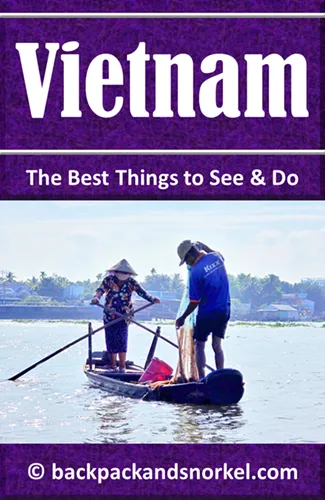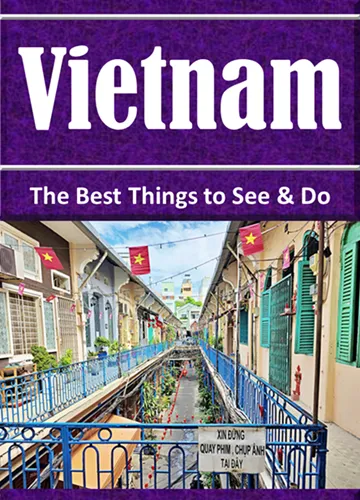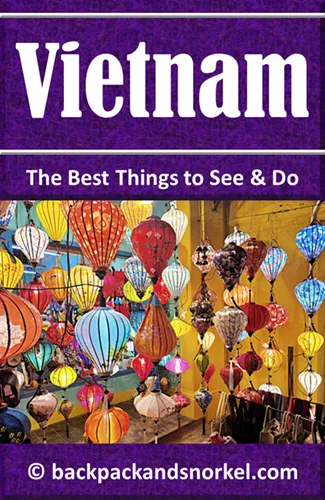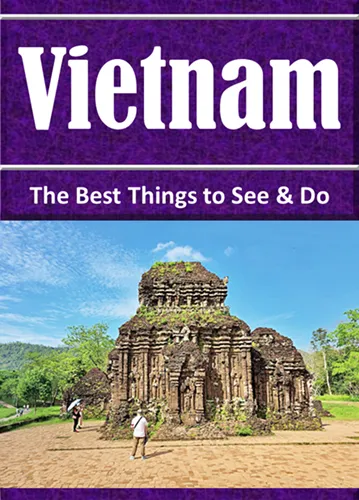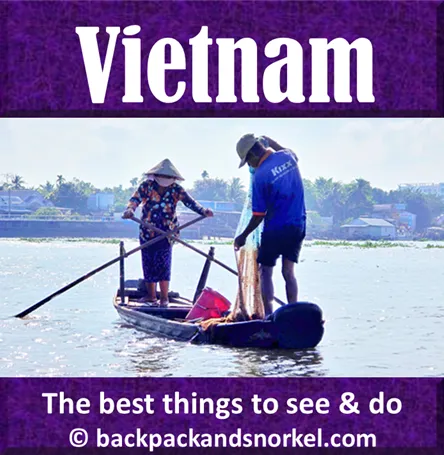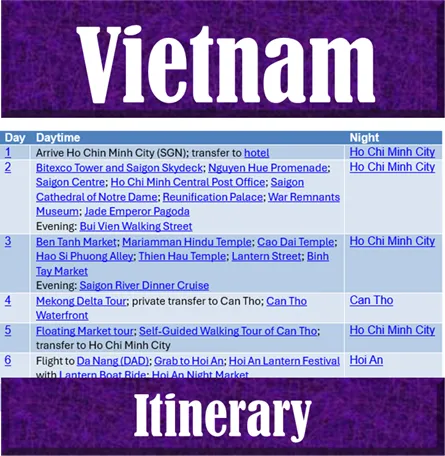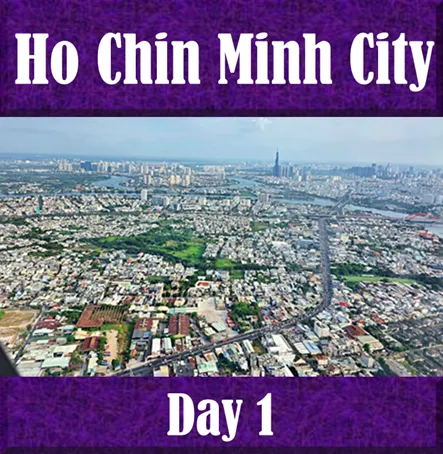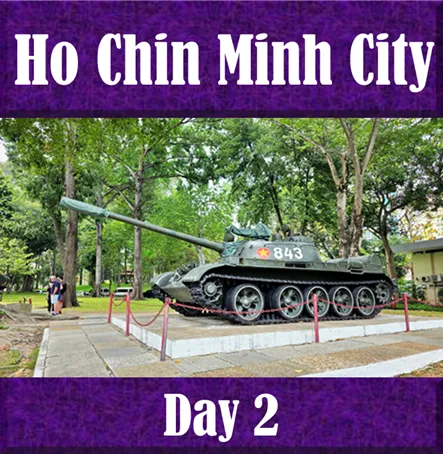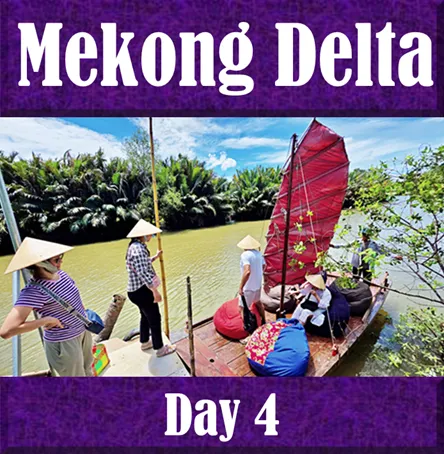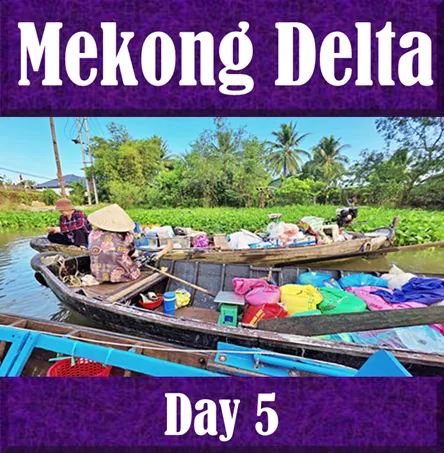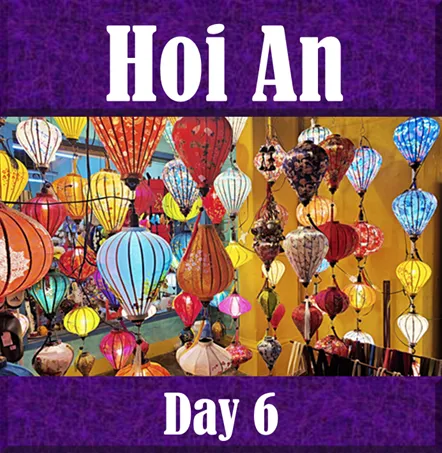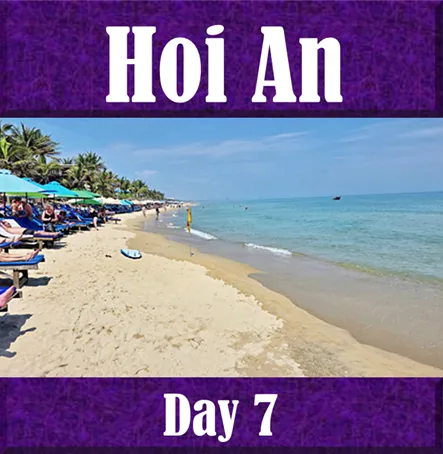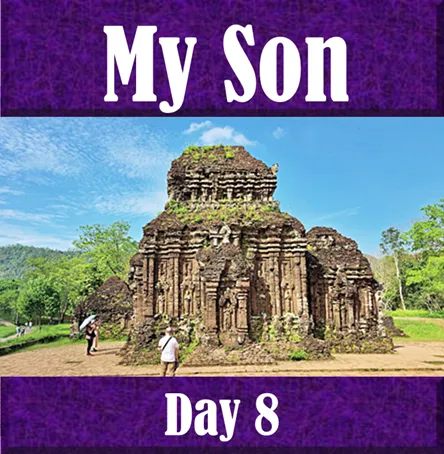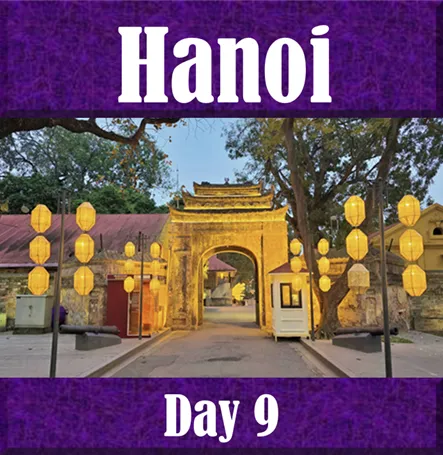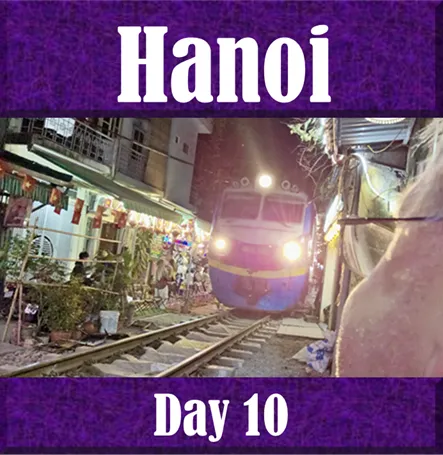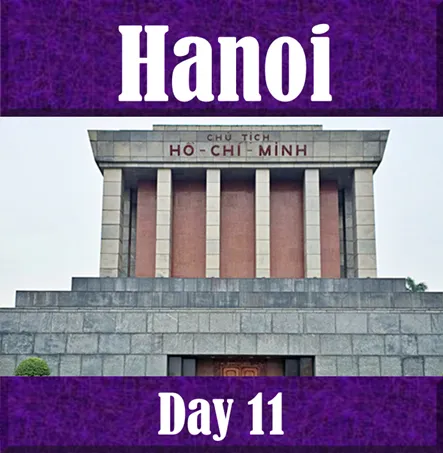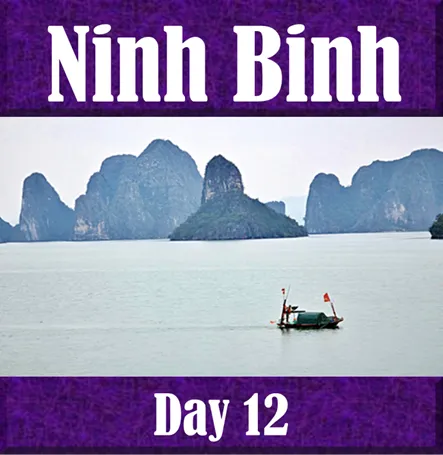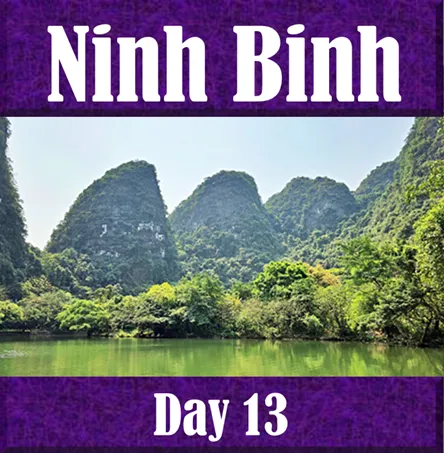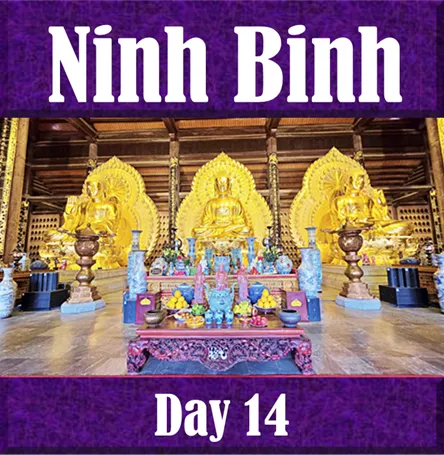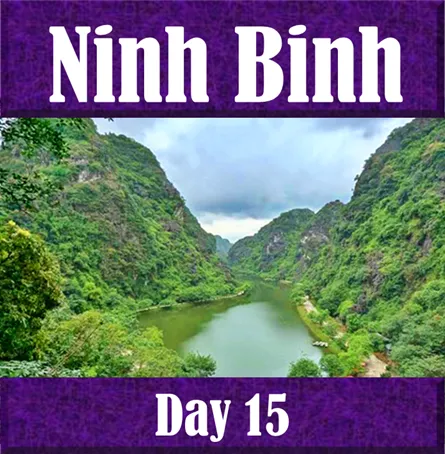Sixteen Day to Three Week Itinerary for Vietnam | Vietnam Purple Travel Guide
The table below contains a 16-day itinerary for Vietnam. Depending on your interests, we are providing four add-ons that you can add to your itinerary and extend it to a 3-week visit or even longer.
The direction you travel, whether from south to north or north to south, can significantly impact your experience, especially concerning the weather. Here is how to make the most of your journey based on the time of year:
Traveling Early in the Year (e.g., March): Start South, End North!
For trips in the early part of the year, like March, we highly recommend beginning your adventure in Ho Chi Minh City in the south, and making your way up to Hanoi in the north. Here is why:
Ho Chi Minh City will steadily warm up as the year progresses. By starting here, you will catch the city at a more comfortable temperature before the intense heat of later months sets in.
Hanoi will be transitioning from its cooler period to warmer temperatures. Traveling north later in your trip means you will experience Hanoi as it becomes less chilly, offering more pleasant sightseeing conditions.
Traveling Later in the Year (e.g., November): Start North, End South!
If your travel plans fall later in the year, such as November, the reverse itinerary is ideal: begin in Hanoi and journey south to Ho Chi Minh City. This strategy helps you chase the best weather:
Hanoi will be getting progressively colder as winter approaches. Starting your trip here allows you to experience the capital before the chill fully sets in.
Ho Chi Minh City will be cooling down from its hot season. By heading south later in your trip, you will arrive in Ho Chi Minh City as it becomes more comfortably warm, rather than intensely hot.
Itinerary for your perfect Vietnam trip
There are four add-ons for your trip that you may want to consider:
Add-on 2: Longer Ha Long Bay/Lan Ha Bay/Bai Tu Long Bay cruise
Add-on 3: Adding a hiking trip in Sa Pa (Sapa) in the far northern part of Vietnam
Add-on 4: Beach relaxation in Vietnam (Phu Quoc Island, Nha Trang)
Cu Chi Tunnels in Ho Chi Minh City
The Củ Chi Tunnels are one of the most visited historical attractions in Vietnam, drawing over 1 million visitors per year from around the world.
We have elected to add them as on optional add-on, as we already visit two Vietnam War sites in Ho Chi Minh City, and don’t want to overload the itinerary with Vietnam War sites. If you are interested in the Vietnam War, then you will be fascinated by the Cu Chi Tunnels.
To add the Cu Chi Tunnels to your itinerary, you will need to add one day to your itinerary, e.g. as Day 4. Since tours from Ho Chi Minh City are typically between 6-8h long, you will need to reserve the full day.
4 |
Full day guided Cu Chi Tunnels tour |
Ho Chi Minh City |
There is a large selection of tours that you can join. We like to book with Viator or GetYourGuide, as they are very customer-oriented, and allow free cancellations typically until up to 24h before the event. Here are Cu Chi Tunnels tours from Viator und GetYourGuide.
Here is what the Cu Chi Tunnels are all about:
Just 38 miles (60 km) northwest of Ho Chi Minh City, the Củ Chi Tunnels offer one of the most immersive and unforgettable historical experiences in Vietnam. This vast underground network, dug and expanded during the Vietnam War, showcases the extraordinary resilience, ingenuity, and determination of the Viet Cong fighters who used it to resist American and South Vietnamese forces.
As mentioned, today, the Củ Chi Tunnels are rightfully one of the most visited historical attractions in Vietnam, drawing travelers, students, and war history enthusiasts from around the world. Whether you are crawling through the narrow passageways, learning about guerrilla tactics, or witnessing remnants of war-era traps and bunkers, this is a powerful journey into Vietnam’s wartime legacy.
A Tunnel System Built for Survival
The Củ Chi Tunnels originated during the late 1940s as a defense against French colonial forces. However, they were massively expanded during the 1960s, especially during the Vietnam War (Second Indochina War). At their peak, the tunnels stretched over 155 miles (250 km), connecting villages, command posts, hospitals, kitchens, living quarters, and supply routes across Củ Chi District and beyond.
The tunnels allowed the Viet Cong to launch surprise attacks and disappear underground before U.S. troops could retaliate. Life below was extremely harsh, infested with insects, plagued by poor air quality, and often requiring people to spend days or even weeks underground.
What You Will Experience at the Củ Chi Tunnels
Today, two major sites are open to visitors: Ben Dinh and Ben Duoc. Both are located about 1.5 hours by car from Ho Chi Minh City and are accessible by guided tour, private taxi, or boat along the Saigon River.
Tunnel Crawl
Visitors have the chance to enter the tunnels themselves, through widened sections made safe for tourists. Still, the passages remain narrow and dimly lit, offering a visceral sense of how claustrophobic life underground must have been.Trap Demonstrations
See replicas of ingenious and brutal booby traps used to injure or deter enemy troops—such as bamboo spike pits, rolling traps, and foot snare devices. These devices highlight the low-tech but highly effective nature of VC defenses.Underground Kitchens and Air Vent Systems
Learn about the ‘Hoàng Cầm stove’, a smokeless cooking system that allowed food to be prepared without revealing the tunnel location to aerial surveillance.Propaganda Film and Exhibits
Your visit often begins with a documentary film (from a North Vietnamese perspective) showing how the tunnel system supported the war effort. Museum exhibits include VC uniforms, weapons, tools, and handmade sandals carved from old tires.Shooting Range (Optional)
At Ben Dinh, thrill-seekers can fire real war-era weapons, including AK-47s and M16s, at an on-site shooting range (extra charge applies). Ear protection is advised—it is very loud.
Which Site to Visit: Ben Dinh vs. Ben Duoc
Ben Dinh
More tourist-friendly and frequently visited. Tunnels are reinforced and slightly expanded for foreign visitors.Ben Duoc
Less crowded and more authentic, offering a deeper and less commercialized experience. Better suited for those who want to understand the local-scale resistance effort.
Pro tip: Wear lightweight, modest clothing, and closed-toe shoes. The tunnel crawl can be hot, dusty, and physically demanding.
Add-on 2: Longer Ha Long Bay/Lan Ha Bay/Bai Tu Long Bay cruise
Some people recommend doing a 2-day 1-night, or even 3-days 2-nights tour in the Ha Long Bay area. This is certainly not a bad idea, but be advised that a 2-day cruise is not very different from a 1-day cruise. The advantage of a longer tour is that you will not feel rushed.
Here is a direct comparison of typical Lan Ha Bay Cruises:
| Day 1 | 1-day cruise | 2-days, 1-night cruise |
|---|---|---|
Early morning |
Depart Hanoi or Ninh Binh |
Depart Hanoi or Ninh Binh |
11am-1pm |
|
|
Afternoon |
|
|
Evening |
Transfer to Hanoi/Ninh Binh/Ha Long City |
|
| Day 2 | ||
Morning |
n/a |
|
Afternoon |
n/a |
Transfer to Hanoi/Ninh Binh/Ha Long City |
Price |
Starting at US$59 per person |
Starting at US$305 per person |
Here are some photos of the Calypso that operates 2 Day 1 Night tours in Lan Ha Bay:
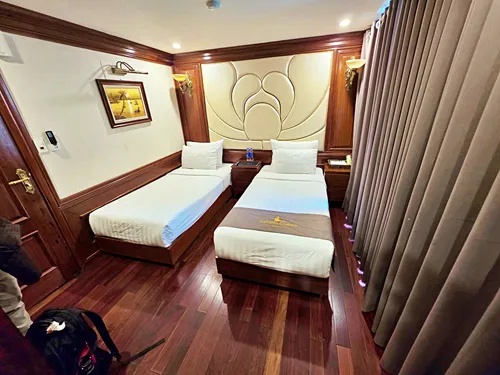
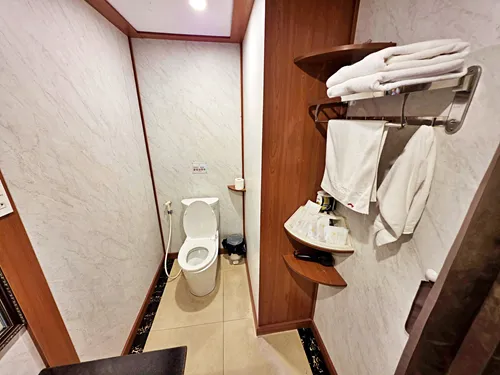
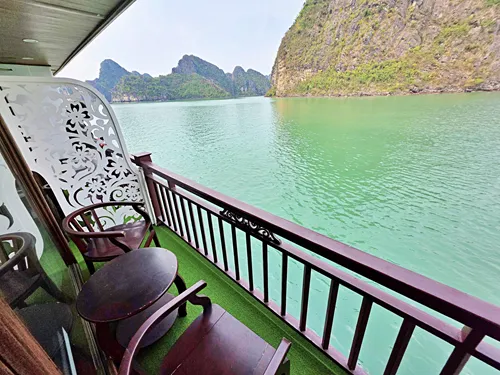
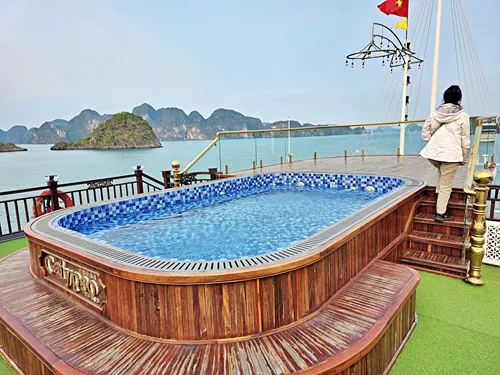
If you prefer to have a more relaxing time in Ha Long Bay/Lan Ha Bay/Bai Tu Long Bay, then you can substitute the original 1-day trip with this 2-day itinerary:
12 |
7-8am hotel pickup; Cruise of Ha Long Bay/Lan Ha Bay/Bai Tu Long Bay; transfer to Ninh Binh |
Boat |
13 |
Cruise of Ha Long Bay/Lan Ha Bay/Bai Tu Long Bay; |
Ninh Binh |
Add-on 3: Adding a hiking trip in Sa Pa (Sapa) in the far northern part of Vietnam
If you have not traveled much in Asia and never seen rice terraces before, then you should definitely consider adding a trip to Sa Pa (Sapa).
If you have seen rice fields and rice terraces before, or if you are not interested in hours-long hiking trips, then you can skip Sa Pa.
Historically, most western visitors have taken the overnight sleeper train from Hanoi to Sa Pa. This is still a good idea if you can sleep on a moving train, and if you want to save money on accommodation for one night.
The more comfortable way, in our opinion, is to book a guided tour from Hanoi that includes a transfer by car on the new high-quality highway that connects Hanoi with Sa Pa.
Here you can find typical Sa Pa tours that include transfers by car: Viator, GetYourGuide.
If you want to do this, then you can add this to the above itinerary:
16 |
Transfer to Sa Pa; check into hotel; lunch; first hike; dinner |
Sa Pa |
17 |
Breakfast; second hike; check out of hotel, transfer back to Hanoi |
Hanoi |
Depending on the time of year, the rice fields will look very different. Here is an overview:
‘Water Pouring’ / Planting Season (Late April to June):
What you will see: The fields are flooded with water, creating a stunning mirror effect that reflects the sky, clouds, and surrounding mountains. Farmers are actively transplanting rice seedlings.
Green Season (July - August):
What you will see: The rice seedlings grow into a vibrant, lush green carpet covering the hillsides.
July can be rainy, but showers are often brief, leaving the air fresh and cool. By August, the rice flowers start to bloom, filling the air with a sweet scent.
Golden Harvest Season (Mid-September to Early October):
What you will see: This is arguably the most famous and breathtaking time to visit. The rice ripens and turns a magnificent golden hue, creating a ‘golden carpet’ cascading down the mountains. You will also see local ethnic minority groups actively harvesting the rice.
This is often considered the peak time for photographers.
Post-Harvest (Late October – Early April):
What you will see: The fields will be bare after the harvest, or being prepared for the next season. The scenery is still beautiful, but lacks the vibrant colors of the other seasons.
Fewer tourists, cooler weather, and excellent for trekking if you prefer a quieter experience.
Add-on 4: Beach relaxation in Vietnam
If you want to add some time on the beach, Vietnam has two popular prime beach locations: Phu Quoc Island, and Nha Trang. Both can be reached via short direct flights from Ho Chi Minh City, and Phu Quoc Island does also have direct flights from Can Tho. So, if you follow our itinerary, you could fly there directly from Can Tho.
Please be advised that neither Phu Quoc Island nor Nha Trang are part of this Vietnam Purple Travel Guide.
If you want to visit any of these locations and have a truly relaxing experience, our proposal is to stay there for at least 3 days, so that your total itinerary gets to about three weeks, or longer if you wish.
The best times to visit Phu Quoc and Nha Trang for a beach vacation are:
Phu Quoc Island
November to April (dry season). This period offers the most sunshine, minimal rainfall, and calm seas, ideal for swimming, snorkeling, and enjoying the beaches.Nha Trang
January to September. During these months, you will experience the most favorable weather conditions with plenty of sunshine and less rain.
Here is more information about both locations:
Phu Quoc Island: Vietnam's Emerald Isle Escape
Why Visit Phu Quoc Island?
Imagine an island where lush rainforest meets sparkling turquoise waters, where golden sunsets paint the sky, and fresh seafood is always on the menu. That is Phu Quoc Island, Vietnam's largest island, which is rapidly becoming one of Southeast Asia's premier island destinations. It offers the perfect blend of natural beauty, relaxed island vibes, and growing luxury, making it an ideal choice for honeymooners, families, and solo travelers seeking an idyllic escape. With a unique 30-day visa exemption for most nationalities arriving by air (must directly arrive at Phu Quoc airport, and have Phu Quoc as the only destination in Vietnam), it is also incredibly accessible for a quick, hassle-free getaway.
How Good are the Beaches?
Phu Quoc's beaches are truly its crown jewels. Known for their soft, often powdery white or golden sands and incredibly clear, calm waters, they invite endless hours of swimming, sunbathing, and watersports.
Long Beach (Bai Truong): Stretching over 12.5 miles (20 km) on the island's west coast, Long Beach lives up to its name. It is the most developed area, lined with resorts, restaurants, and bars, and offers breathtaking westward sunsets – a daily spectacle. While some parts are bustling, you can still find quieter stretches for a peaceful afternoon.
Sao Beach (Bai Sao): Often lauded as one of Vietnam's most beautiful beaches, Sao Beach in the southeast boasts pristine white sand that contrasts stunningly with the vibrant turquoise sea . It is perfect for swimming, kayaking, and simply unwinding in a picturesque setting.
Ong Lang Beach (Bai Ong Lang): ocated on the northwest coast, Ong Lang offers a more rustic and tranquil charm. It is a series of sandy coves interspersed with rocky outcrops, providing a peaceful escape from the more developed areas, and still delivers fantastic sunsets.
Khem Beach (Bai Khem): Tucked away in the south, Khem Beach is known for its incredibly fine, white sand and secluded feel. While some sections are now part of luxury resorts, its natural beauty remains captivating.
Starfish Beach (Rach Vem): A unique spot in the north, famous for the numerous red starfish often visible in its clear, shallow waters. It is a charming fishing village with stilt raft restaurants offering incredibly fresh seafood.
What Else Can You Do On Phu Quoc Island?
Phu Quoc offers more than just stunning beaches. The island is rich in natural wonders and unique attractions:
Island Hopping & Snorkeling/Diving: Explore the smaller surrounding islands of the An Thoi archipelago in the south. Tours often take you to places like Gam Ghi, May Rut, and Mong Tay islands for snorkeling in vibrant coral reefs, swimming, and relaxing on secluded beaches. Phu Quoc is considered one of the best places for snorkeling and diving in Vietnam.
Ride the Hon Thom Cable Car: Experience the world's longest non-stop three-rope cable car, connecting An Thoi Town to Hon Thom Island. Soar high above the sea for incredible panoramic views of the archipelago, fishing boats, and coral reefs. Hon Thom Island also hosts a large water park (Sun World Hon Thom Nature Park).
Visit a Pepper Farm: Phu Quoc is famous for its high-quality pepper. Take a tour of a local pepper farm to learn about the cultivation process and sample the island's renowned spice.
Explore Phu Quoc National Park: Covering a significant portion of the island, the national park protects lush forests, waterfalls (like Suoi Tranh), and diverse wildlife. It is ideal for hiking and appreciating the island's interior.
Phu Quoc Night Market (Duong Dong): Dive into the bustling heart of Duong Dong town in the evening. This pedestrian-only market is a feast for the senses, offering an incredible array of fresh seafood, local delicacies, and souvenirs.
VinWonders & Vinpearl Safari: For family-friendly entertainment, the north of the island hosts VinWonders, a large amusement park, and Vinpearl Safari, Vietnam's largest semi-wild animal conservation park.
Dinh Cau Rock Temple: A unique temple perched on a rocky headland near Duong Dong town, offering picturesque views, especially at sunset.
How to Get There:
Phu Quoc is very accessible:
By Air: Phu Quoc International Airport (PQC) receives direct flights from major cities in Vietnam (Ho Chi Minh City, Hanoi, Da Nang, Can Tho) and an increasing number of international destinations. This is the quickest and most convenient way to reach the island.
By Ferry/Speedboat: You can take a ferry or speedboat from coastal towns on the mainland like Rach Gia or Ha Tien. The journey takes approximately 1.5 to 2.5 hours. This option is popular for those combining Phu Quoc with a trip to the Mekong Delta.
Nha Trang: Vietnam's Lively Coastal Gem
Why Visit Nha Trang?
If you are seeking a dynamic beach vacation that perfectly blends sun, sea, and city excitement, Nha Trang is your ideal Vietnamese destination. Situated on Vietnam's south-central coast, this bustling city boasts a stunning long crescent-shaped beach, a vibrant urban pulse, and a gateway to a myriad of aquatic adventures. It is particularly popular with those who enjoy a lively atmosphere with plenty of dining, nightlife, and activity options right on their doorstep.
How Good are the Beaches?
Nha Trang's beaches are a major draw, offering extensive stretches of sand and clear waters.
Tran Phu Beach (Nha Trang Beach): This is the city's centerpiece – a magnificent 4.3 mile (7 km) stretch of golden sand that runs parallel to a bustling promenade, lined with hotels, resorts, restaurants, and bars. It is the hub of activity, perfect for sunbathing, swimming, and various water sports like jet skiing and parasailing. While it can get busy, its sheer size means there's always space.
Doc Let Beach: Located about 25 miles (40 km) north of Nha Trang city, Doc Let offers a quieter, more pristine escape. It is known for its exceptionally white, powdery sand, shallow, calm waters, and charming, less-developed atmosphere, making it ideal for families and those seeking tranquility.
Hon Chong Beach: Found on the northern side of Nha Trang, this beach is distinguished by its unique rock formations and offers picturesque views of the ocean. It is a great spot for photography and a more peaceful afternoon by the sea.
Bai Dai Beach: South of the city, near Cam Ranh Airport, Bai Dai is a long, expansive beach with a relaxed vibe. It is gaining popularity for its seafood shacks and is a great option for a more local beach experience away from the city's main hustle.
Hon Tre Island Beaches: This large island in Nha Trang Bay is home to VinWonders Nha Trang and several luxurious resorts. Beaches here, like Bai Tru, are often more secluded and pristine, offering a resort-style beach experience accessed via cable car or speedboat.
What Else Can You Do There?
Nha Trang offers a diverse range of activities beyond just beach lounging:
Island Hopping & Diving/Snorkeling: Nha Trang Bay is dotted with numerous islands. Take a boat tour to explore these islands, stopping for snorkeling in coral reefs (Hon Mun Marine Protected Area is renowned), swimming, and enjoying fresh seafood lunches. It is a major diving hub in Vietnam, catering to all skill levels.
VinWonders Nha Trang: Located on Hon Tre Island, this massive amusement park offers thrilling rides, a water park, an aquarium, and various entertainment shows, accessible via the world's longest over-sea cable car. It is a full-day adventure, especially for families.
Po Nagar Cham Towers: Immerse yourself in history at these ancient Hindu temples, built by the Cham people between the 7th and 12th centuries. Perched on a hill, they offer historical insights and panoramic views of the city and river.
Long Son Pagoda & White Buddha: Visit this serene Buddhist pagoda, famous for its impressive white Buddha statue seated atop a hill, offering another vantage point for city views after climbing numerous steps.
Thap Ba Hot Spring Centre: Indulge in a unique mud bath experience! This popular complex offers therapeutic mud baths, hot mineral springs, and swimming pools, perfect for relaxation and rejuvenation after a day of sightseeing.
Nha Trang Nightlife: The city comes alive after dark with numerous beach clubs (like Sailing Club), rooftop bars, and restaurants offering a vibrant atmosphere for evening entertainment.
Local Markets: Explore Dam Market for a taste of local life, where you can find everything from fresh produce and seafood to souvenirs and clothing.
How to Get There:
Nha Trang is well-connected and easy to reach:
By Air: Cam Ranh International Airport (CXR), located about 30-45 minutes south of Nha Trang city, serves as the main gateway. It has frequent direct flights from major Vietnamese cities (Hanoi, Ho Chi Minh City, Da Nang) and some international routes. Taxis and shuttle buses are readily available from the airport to the city.
By Train: Nha Trang is a major stop on Vietnam's North-South railway line (‘Reunification Express’). Overnight trains are a popular and scenic option from cities like Ho Chi Minh City, Da Nang, and Hanoi, offering a glimpse of the Vietnamese countryside.
By Bus: Long-distance buses connect Nha Trang to most major cities and towns across Vietnam. While more affordable, journeys can be long depending on your departure point.
Where do you want to go now?
Author: Rudy at Backpack and Snorkel
Bio: Owner of Backpack and Snorkel Travel Guides. We create in-depth guides to help you plan unforgettable vacations around the world.
Other popular Purple Travel Guides you may be interested in:
Like this Backpack and Snorkel Purple Travel Guide? Pin these for later:
